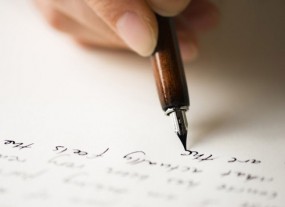 How many of you still handwrite? I don’t just mean a letter to a friend or relative (although handwritten letters are growing increasingly rare) or a reminder to do something or shopping list. I’m referring to writing prose, creative non-fiction, poetry or any kind of expression with a pen or pencil.
How many of you still handwrite? I don’t just mean a letter to a friend or relative (although handwritten letters are growing increasingly rare) or a reminder to do something or shopping list. I’m referring to writing prose, creative non-fiction, poetry or any kind of expression with a pen or pencil.
University student Cynthia Selfe said, “I like the motion, pushing that lead across the page…filling up pages … I like flipping papers and the action of writing. It makes me feel close to what I’m saying.”
Handwriting is an art that many of us are losing.
A June 2014 New York Times article by Maria Konnikova shares neuro-scientific evidence that links handwriting with a broader educational development. “Children not only learn to read more quickly when they first learn to write by hand, but they also remain better able to generate ideas and retain information. In other words, it’s not just what we write that matters—but how.” Experiments done with young children showed that when they drew a letter freehand, they showed increased activity in three areas of the brain activated in adults when they read and write: the left fusiform gyrus, the inferior frontal gyrus and the posterior parietal cortex. Children who typed or traced the letter showed no such effect. Researchers at Indiana University attributed the differences to the messiness inherent in free-form handwriting: “not only must we first plan and execute the action in a way that is not required when we have a traceable outline, but we are also likely to produce a result that is highly variable,” reported Konnikova. That variability may itself be a learning tool. “When a kid produces a messy letter,” said Dr. Karin James, psychologist at Indiana University, “that might help him learn it.”
We learn best heuristically, through experience.
Handwriting slows us down. It is a sensual and intimate way for us to express ourselves. I love my handwriting, especially when I am using my favorite pen (my handwriting changes depending on the pen), a fine felt marker — usually black. When you use a pen or pencil to express yourself you have more ways to express your creativity. Think of the subtleties of handwriting alone: changing the quality and intensity of strokes; designing your script, using colors, symbols, arrows or lines, using spaces creatively, combining with drawing and sketches. In combination with the paper (which could be lined, textured, colored graphed, etc.), your handwritten expression varies as your many thoughts and moods.
The very act of handwriting focuses you. Writing your words by hand connects you more tangibly to what you’re writing through the physical connection of pen to paper. Researchers have proven that just picking up a pencil and paper to write out your ideas improves your ability to think, process information and solve problems. The actual act of writing out the letters takes a little more work in your brain than just typing them on a keyboard, and that extra effort keeps your mind sharp. Researchers have also shown that writing something out by hand improves your ability to remember it. Handwriting improves memory, increases focus, and the ability to see relationships.
Handwriting fuses physical and intellectual processes. American novelist Nelson Algren wrote, “I always think of writing as a physical thing.” Hemmingway felt that his fingers did much of his thinking for him.
According to Dr. Daniel Chandler, semiotician at Aberystwith University, when you write by hand you are more likely to discover what you want to say. When you write on a computer, you write “cleanly” by editing as you go along and deleting words (along with your first thoughts). In handwriting, everything remains, including the words you crossed out. “Handwriting, both product and process,” says Chandler, “is important … in relation to [your] sense of self.” He describes how the resistance of materials in handwriting increases the sense of self in the act of creating something. There is a stamp of ownership in the handwritten words that enhances a sense of “personal experience.”
I know this is true in my own writing experience. This is why, although I do much of my drafting of novel, article and short story on the computer, I find that some of my greatest creative moments come to me through the notebook, which I always keep with me. Writing in my own hand is private and resonates with informality and spontaneity (in contrast to the fixed, formal look and public nature of print). Handwriting in a notebook is, therefore, a very supportive medium of discovery and the initial expression of ideas.
“I am certainly no calligrapher,” admits novelist and poet Wendell Berry, “but my handwritten pages have a homemade, handmade look to them that both pleases me in itself and suggests the possibility of ready correction.” Writer John O’Neill calls handwriting “bodily art.” He suggests that, “the writer’s fingers and the page are a working ensemble, and alternation of intelligible space and spatialized intelligence.”
Berry goes on to say this: “Language is the most intimately physical of all the artistic means. We have it palpably in our mouths; it is our langue, our tongue. Writing it, we shape it with our hands. Reading aloud what we have written — as we do, if we are writing carefully — our language passes in at the eyes, out at the mouth, in at the ears the words are immersed and steeped in the senses of the body before they make sense in the mind. They cannot make sense in the mind until they have made sense in the body. Does shaping one’s words with one’s own hand impart character and quality to them, as does speaking them with one’s own tongue to the satisfaction of one’s own ear?… I believe that it does.”
Cursive Writing: Losing More Than an Art Form
John Boone’s November 15th 2013 article on Eonline reads: “Cursive handwriting will no longer be taught in schools because it’s a big, old waste of time”. Besides the controversy at the time—it’s old news now—I was curious to read how seven states, namely California, Idaho, Indiana, Kansas, Massachusetts, North Carolina and Utah, fought to keep cursive in the curriculum, arguing that it helped distinguish the literate from the illiterate. “Joke’s on them because all kids are illiterate these days,” Boone scoffs. He cites computers as the reason. Of course. Let’s not forget texting on Smart phones and other communication devices that encourage the use of a bastardized form of English. Schools promote keyboarding as a productive alternative based on its direct application to career success. But what about the subtle, integrative, sociological, psychological and creative benefits of handwriting?
There is a spill-over benefit for thinking skills used in reading and writing. Research has shown that learning cursive writing is directly related to literacy, the ability to read well and to comprehension generally. Scientists discovered that learning cursive is an important tool for cognitive development. The brain develops functional specialization through cursive writing that integrates sensation, movement control, and thinking. Brain imaging studies reveal that multiple areas of brain become co-activated during the learning of cursive writing of pseudo-letters, as opposed to typing or just visual practice. To write legible cursive, fine motor control is needed over the fingers. You have to pay attention and think about what and how you are doing it. You have to practice. Brain imaging studies show that cursive activates areas of the brain that don’t participate in keyboarding. Psychologists at Princeton and the University of California reported that students learned better when they took notes by hand than when they typed on a keyboard. Handwriting, they reported, allowed the student to process a lecture’s contents and reframe it, to reflect and manipulate that can lead to better understanding and memory encoding.
In an April 2013 New York Times article, Kate Gladstone shared that handwriting matters, but not cursive. She further shared that adults increasingly abandon cursive. A recent survey of handwriting teachers revealed that over half used a hybrid of cursive and print: some elements resembling print-writing, others resembling cursive. I myself have adopted this hybrid form of handwriting since grade five (despite the authoritative perambulations of my teacher). But, if I hadn’t learned cursive to begin with, I wouldn’t be in the position to hybridize it with print. Cursive is a life-skill, whose subtle merits we have yet, and may never, fully discern. Instead of using Gladstone’s inappropriate metaphors of abacus or slide rule, learning cursive is better compared with learning notes for music or learning how to add, subtract and divide to do higher math.
We are poised to slide down an insidious and dangerous path. To willingly give up a basic ability and skill that will inevitably close doors in knowledge, particularly historical knowledge, is akin to handing over a piece of your freedom and heritage. It is actually more insidious than that: When your son Johnny can’t sign his own name on a document, he loses more than his ability to identify himself as a unique individual and citizen with inalienable rights; he has lost his very identity. Printing your name is akin to marking X. And that’s the situation some kids are finding themselves in today.
In another New York Times article, Morgan Polikoff recommends that educators and policymakers resist the urge to add more skills (referring to cursive, as if it hadn’t been there to begin with). “Doing so would simply result in a crowded, less-focused curriculum, undermining the strength of the standards,” Polikoff ended. I find this ironic; because the reality is that cursive writing as a taught skill goes hand in hand with active handwriting. If time is not devoted to cursive, it’s not devoted to handwriting. And THAT will have grave consequences. The truth is that going to exclusive print-writing will eventually lead to no handwriting at all. Students will opt to use keyboarding exclusively and handwriting will go the way of the slide rule and the abacus. How will the exclusive use of the keyboard affect the act of writing and expression, generally? It will be certainly at the expense of artistic expression and creativity itself.
“Many people now cannot form legible letterforms at all except by tapping on a keyboard. For those people, writing and the alphabet have, quite literally, ceased to be human. How do you expect to be able to cook good food or make good love when you write with prefabricated letters? How do you expect to have good music if you live on a typographic diet of bad Helvetica and even worse Times New Roman—never mind the parodies of letters that flash across your cellphone screens and the parodies of numbers marching over the screens of your pocket calculators and cash-dispensing machines? How can things so ill-formed have a meaning?”—Wendel Berry, The Typographic Mind (in Everywhere Being Is Dancing)
In medieval times only a small elite could read and write; they created the stories and recorded them in glorious illuminated manuscripts for future storytellers. They created history. The masses made do with handing down stories through oral storytelling, which, because it was not tangibly recorded, morphed and was eventually lost like water down a flowing river. The power lay in the script. What was handed down.
If we are not careful, the ability to read and write will become the sole pursuit of an elite, those few who will hold the key to interpreting the past. And ultimately controlling the future.











Recent Comments